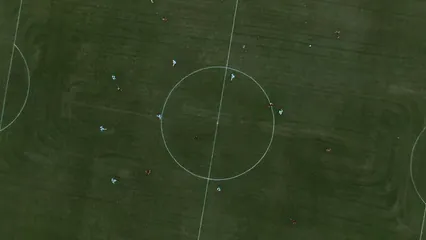Introduction
Luka Modric, the maestro of midfield, has graced football with his exceptional talent. Born in 1985 in Croatia, Modric’s journey from a war-torn childhood to becoming a football icon is nothing short of inspirational. His agility, vision, and passing abilities have made him a cornerstone of Real Madrid and the Croatian national team.
Analyzing player statistics is like reading a footballer’s biography in numbers. It reveals how effective they are on the pitch and their contributions to the team’s success. Modric’s statistics offer insights into his performance, helping fans and analysts appreciate his influence on the game.
This article explores the depths of Modric’s career statistics, seasonal breakdowns, and key achievements. From his early days at Dinamo Zagreb to lifting the Champions League trophy with Real Madrid, we will uncover the numbers behind the legend. Get ready to dive into the impressive stats that showcase why Luka Modric is often hailed as one of the greatest midfielders of all time.

Speaking of trophies, why not celebrate your love for football with a UEFA Champions League Trophy Replica? It’s like having a piece of history right in your living room, minus the need to lift it after a match!
Historical Overview of Luka Modric
Luka Modric’s story begins in Zadar, Croatia, where he was born into a humble family. His early life was marked by the Croatian War of Independence, forcing his family to flee. Despite these challenges, Modric’s passion for football never waned. At just six years old, he began playing for a local club, Zadar.
His talent caught the eye of Dinamo Zagreb, where he signed his first professional contract at 16. Modric thrived in the youth ranks, leading to his debut in 2005. Over the next few years, he helped Dinamo secure multiple league titles while showcasing his dribbling and passing skills. In 2008, Modric made a significant career move, joining Tottenham Hotspur in the Premier League.
At Tottenham, Modric faced a steep learning curve but quickly established himself as a key player. His performances in the league and UEFA competitions gained the attention of top clubs. In 2012, Real Madrid came calling, and Modric made the leap to La Liga, where he would solidify his legacy.
Since joining Real Madrid, Modric has achieved numerous milestones. He has been instrumental in the club’s success, contributing to multiple Champions League titles and domestic victories. His leadership on the pitch was recognized when he captained the Croatian national team, leading them to the World Cup final in 2018, where he was awarded the Golden Ball for best player.
From his humble beginnings to the pinnacle of football success, Luka Modric’s journey is a testament to hard work, talent, and resilience. His statistics reflect a player who has not only adapted to different leagues but has also consistently performed at the highest level, making him a true football legend.

Early Career
Modric’s professional journey began at Dinamo Zagreb, where he made an immediate impact. In his first season, he played 25 matches, scoring eight goals and providing four assists. He was a creative force, helping the team to win the league title. By the end of his tenure, he had amassed a total of 94 appearances, netting 26 goals, and showcasing his exceptional playmaking abilities.
In 2008, he joined Tottenham Hotspur, where he played 127 matches over four seasons. During his time in the Premier League, Modric scored 13 goals and assisted another 19. His ability to control the midfield and dictate the pace of the game was evident, making him a fan favorite. He helped Tottenham secure a spot in the Champions League, further enhancing his reputation.
Modric’s early career statistics not only demonstrate his scoring prowess but also his ability to create opportunities for his teammates. These formative years laid the groundwork for a successful career that would see him become one of the most decorated players in football history. Each statistic tells a story of a young player growing into a world-class talent, ready to take on the challenges of top-flight football.

And if you’re looking to show off your support for Modric, grab yourself a Luka Modric Jersey. Wear it proudly as you cheer on your favorite midfielder!
Real Madrid Tenure
Luka Modric’s career at Real Madrid has been nothing short of legendary. Joining the club in 2012, he embarked on a journey that would see him become one of the most decorated players in football history. Over his time at the club, Modric has won a staggering six UEFA Champions League titles and four La Liga championships, among numerous other trophies.
The midfielder’s influence on the team cannot be overstated. He has been the heartbeat of the midfield, orchestrating play and dictating the tempo of matches. His vision and passing ability have not only contributed to his goals but have also opened up scoring opportunities for his teammates. Each season, Modric has played a crucial role in Real Madrid’s success, often stepping up in critical moments.
From the 2012-2013 season to the current season, Modric has showcased his talent across multiple campaigns. His debut season saw him play 25 matches, contributing one goal and two assists. Fast forward to the 2023-2024 season, where he played 32 matches, scoring four goals and assisting six times. His consistent performance has earned him a permanent place in the hearts of Real Madrid fans.
Here’s a breakdown of his statistics at Real Madrid:
- Total Matches Played: 368
- Goals: 28
- Assists: 58
The numbers speak volumes about his contributions. Modric’s ability to rise to the occasion during crucial matches has made him a fan favorite. He has been pivotal in securing victories in both domestic and international competitions, often providing that sprinkle of magic when the team needs it most.

His statistics in various competitions further illustrate his impact. In La Liga alone, Modric has made 368 appearances, scoring 28 goals and providing 58 assists. In the UEFA Champions League, he has featured in 130 matches, with 9 goals and 19 assists to his name. This level of consistency across multiple seasons highlights his importance to the team.
Modric’s accolades during his tenure at Real Madrid are equally impressive. He was awarded the Ballon d’Or in 2018, breaking the decade-long dominance of Lionel Messi and Cristiano Ronaldo. He also received the FIFA Best Men’s Player award the same year, further solidifying his status as one of the greatest midfielders of all time.
And if you’re looking to improve your own game, you might want to check out a Football Tactics Board. It’s a great tool to strategize your game like the pros!
Beyond the statistics, Modric’s leadership qualities shine through. He has been a mentor to younger players and a reliable figure on the pitch. His experience and calmness under pressure have helped guide Real Madrid through challenging moments.
As we analyze Modric’s legacy at Real Madrid, it’s clear that his contributions go beyond mere numbers. He has redefined the role of a midfielder, showcasing how a player can influence a game through intelligence, skill, and creativity.
Luka Modric’s journey at Real Madrid is a testament to his hard work and dedication. His presence in the team has not only brought success but has also inspired the next generation of footballers. The club and its fans are undoubtedly grateful for the years of exceptional service he has provided.

Analysis of Current Season (2024-2025)
In the current season, Luka Modric continues to impress, proving that age is just a number. With Real Madrid striving for success in both La Liga and the UEFA Champions League, Modric’s contributions have been crucial.
So far, he has played in 12 matches, scoring 2 goals and providing 2 assists. His ability to create plays and maintain possession has been vital for the team. Modric’s presence in the midfield ensures that the team maintains control, often acting as a link between defense and attack.
Here’s a detailed look at his performance this season:
- Total Matches Played: 12
- Goals: 2
- Assists: 2
- Yellow Cards: 3
- Red Cards: 0
Comparing this season to previous ones showcases Modric’s consistency. In the 2023-2024 season, he played 32 matches, scoring 4 goals and assisting 6. The numbers reflect a small dip in goal-scoring but highlight his continued role as a playmaker.
His experience and tactical awareness have helped him adapt his game. With the emergence of younger talents like Jude Bellingham, Modric has adjusted his style, focusing more on creating opportunities rather than solely finishing. His passing accuracy remains impressive, hovering around 91%, indicating his reliability in distributing the ball effectively.
The statistics from the current season show that Modric is still capable of impacting games significantly. His expected goals (xG) of 0.34 reflects his ability to find scoring opportunities, while his expected assists (xA) of 1.52 highlights his role in setting up teammates. These metrics further demonstrate his ongoing importance in the midfield.
Notably, Modric’s discipline on the field has improved. With only 3 yellow cards so far, he has managed to avoid being overly aggressive, maintaining composure in crucial matches. This maturity is a testament to his experience, allowing him to influence games without unnecessary fouls.
As the season progresses, Modric’s role as a leader on and off the pitch remains pivotal. His ability to mentor younger players, combined with his vast experience, positions him as a key figure in Real Madrid’s quest for silverware this season.
In summary, Luka Modric is still a force to be reckoned with in the world of football. His statistics this season, coupled with his past achievements, reinforce his status as one of the all-time greats. With several months left in the season, fans eagerly await to see how he continues to contribute to Real Madrid’s success.

Competition Breakdown
Luka Modric has dazzled fans with his performance across various competitions. Let’s break down his statistics in La Liga, the UEFA Champions League, and international competitions with the Croatian national team.
La Liga
In La Liga, Modric has consistently demonstrated his value as a midfield maestro. Over his tenure at Real Madrid, he has made 368 appearances, scoring 28 goals and providing 58 assists. His playmaking ability shines through in these numbers, showcasing his knack for creating scoring opportunities.
In the current season (2024-2025), Modric has played in 9 matches, contributing 1 goal and 1 assist. His passing accuracy in La Liga remains impressive, hovering around 91%. This accuracy emphasizes his ability to control the game’s tempo, ensuring that possession stays with Real Madrid. His performance against teams like Villarreal and Espanyol highlights his importance in crucial matches, as he registered assists that led to victories.

UEFA Champions League
Moving to the UEFA Champions League, Modric’s contributions are equally noteworthy. He has featured in 130 matches, netting 9 goals and providing 19 assists. This competition often showcases the best of the best, and Modric has risen to the occasion time and time again.
In the current season, he has appeared in 2 matches, scoring 1 goal and assisting another. His experience and composure in high-pressure situations are invaluable assets to the team. Modric’s ability to read the game allows him to make critical passes that can change the course of a match, making him a key figure during knockout stages.

International Competitions
On the international stage, Modric has been a stalwart for the Croatian national team since making his debut in 2006. With 180 caps and 27 goals to his name, he has played in multiple tournaments, including the FIFA World Cup and UEFA European Championship.
His leadership was instrumental during Croatia’s memorable run to the World Cup final in 2018, where he earned the Golden Ball award for the tournament’s best player. In the recent UEFA Nations League matches, Modric scored 1 goal and provided 3 assists, demonstrating that he continues to perform at a high level, even as he ages.
Overall, Luka Modric’s statistics across different competitions reflect his evolution as a player and his ability to impact matches significantly. His contributions are not merely numbers; they represent his dedication, skill, and the legacy he is building in football history. With each match, he reinforces his status as one of the greatest midfielders of all time.

Advanced Statistics and Metrics
As football evolves, so do the metrics used to analyze players’ performances. Advanced statistics like Expected Goals (xG) and Expected Assists (xA) offer deeper insights into a player’s contributions beyond traditional stats. Luka Modric’s metrics in these areas highlight his importance on the pitch.
Expected Goals (xG) measures the likelihood of a goal being scored based on various factors, including shot location and type. In the current season, Modric has an xG of 0.34, indicating he’s been in positions to score, even if he hasn’t converted as many chances as in previous seasons. This metric showcases his ability to find himself in the right spots, hinting at his sharp attacking instincts.
Similarly, his Expected Assists (xA) stands at 1.52, underscoring his role as a facilitator. This metric reflects the quality of chances he creates for teammates. With an xA of 1.52, it’s evident that Modric continues to serve as the engine of Real Madrid’s attack, orchestrating plays and linking the midfield with the forwards.
When we look at his passing accuracy, Modric boasts an impressive rate of around 91%. This figure illustrates his reliability in distributing the ball and maintaining possession, crucial for a team that thrives on controlling the game. Additionally, his shot-creating actions per game hover around 5.72, a testament to his playmaking prowess.
Defensively, Modric also contributes significantly. He averages about 1.19 tackles and 1.04 interceptions per game, which indicates that he’s not just an attacking threat but also a committed defender. His ability to retrieve the ball and transition from defense to attack is invaluable.
In summary, advanced statistics provide a comprehensive view of Luka Modric’s contributions on the pitch. His xG and xA metrics reveal a player who creates opportunities and is frequently involved in scoring situations. Coupled with his exceptional passing accuracy and defensive contributions, Modric continues to be an indispensable asset for Real Madrid and the Croatian national team. As he progresses through the current season, fans and analysts alike will keenly watch his statistics for further evidence of his enduring impact in football.

Positional Analysis
Luka Modric is more than just a name; he’s a football chameleon. Over the years, he has graced multiple positions on the field, showcasing a versatility that few can match. Primarily, Modric plays as a central midfielder (CM), but he has also taken on roles as an attacking midfielder (AM) and right midfielder (RM). Each position brings out different aspects of his game, affecting his statistics and contributions.
As a central midfielder, Modric is often the heartbeat of the team. His statistics reflect his ability to orchestrate play, with an impressive passing accuracy hovering around 91%. This position allows him to dictate the tempo, distribute the ball effectively, and create scoring opportunities. In La Liga, for instance, he has made 368 appearances, scoring 28 goals and providing 58 assists. Those numbers reveal just how influential he is in the midfield.
Transitioning to the attacking midfield role, we see a slight shift in his statistics. Here, Modric’s creativity shines even brighter. He becomes a direct link between midfield and attack, often finding himself in positions where he can take shots or set up teammates. This change in position can lead to more assists, as seen during his time at Real Madrid. His ability to read the game allows him to exploit defensive weaknesses, leading to crucial contributions in key matches.
Playing as a right midfielder presents a different challenge. While this role requires him to adapt to wider play, it also allows him to utilize his dribbling skills. Modric’s agility and quick footwork make him a threat down the flanks, creating opportunities for cut-backs or crosses into the box. His statistics in this role may not be as prolific in goals, but they showcase his adaptability.
Modric’s versatility doesn’t just benefit him; it enhances team dynamics significantly. His ability to switch between positions allows coaches to adjust their tactics mid-game, providing flexibility that is invaluable in high-stakes matches. This adaptability helps maintain team cohesion, especially when facing tough opponents or during injuries.
In summary, Luka Modric’s positional versatility is a key element of his success. His statistics vary by position, showcasing his ability to impact the game in multiple ways. Whether orchestrating play from the center, creating chances in attack, or providing width on the right, Modric remains an essential player for both club and country. His continued evolution keeps fans and analysts alike on their toes, eagerly awaiting his next move.
Key Achievements and Accolades
Luka Modric’s trophy cabinet is a testament to his skill, dedication, and hard work. His journey has been filled with individual awards and team achievements that highlight his status as one of football’s all-time greats.
One of the crowning jewels of Modric’s career is the prestigious Ballon d’Or, which he won in 2018. This award recognized him as the best player in the world, breaking the decade-long dominance of Lionel Messi and Cristiano Ronaldo. It was a monumental moment not just for Modric, but for Croatian football as well, showcasing that talent knows no boundaries. That same year, he also earned the FIFA Best Men’s Player award, further solidifying his place among the elite.
Modric’s accolades extend beyond individual honors. He has played a pivotal role in Real Madrid’s success, contributing to six UEFA Champions League titles and four La Liga championships. His influence on the pitch has been undeniable, with countless assists, crucial goals, and a knack for performing in high-pressure situations. He has been a key player during the club’s golden era, helping secure victories in multiple competitions.
In addition to club success, Modric has made significant contributions to the Croatian national team. He led Croatia to the FIFA World Cup final in 2018, a remarkable achievement that culminated in him receiving the Golden Ball as the tournament’s best player. This was a moment of national pride, as he helped put Croatia on the global football map.
Furthermore, Modric has been recognized multiple times in the UEFA Team of the Year and the FIFA FIFPro World XI. These selections reflect his consistency and impact on the game, cementing his legacy as one of the best midfielders in history.
His achievements are not merely a reflection of individual brilliance; they also underscore his ability to elevate those around him. Modric’s leadership qualities have been evident throughout his career, serving as a mentor to younger players and a stabilizing force in the team.
In conclusion, Luka Modric’s accolades are a testament to his hard work, skill, and unyielding passion for the game. Each award tells a story of triumph, both personally and for his teams. As he continues to play, fans can only imagine what more he will achieve, adding further chapters to his already illustrious career.

If you want to add a touch of football flair to your home, consider getting some Soccer Wall Art. Perfect for inspiring your inner football fanatic!
Conclusion
Luka Modric’s career is a tapestry of triumph. From his humble beginnings in Croatia to conquering the world’s biggest football stages, his achievements are monumental. Modric has won six UEFA Champions League titles, four La Liga championships, and numerous individual accolades, including the Ballon d’Or in 2018. These milestones not only highlight his skills but also his resilience and leadership on the pitch.
Statistics play a crucial role in understanding Modric’s impact. They offer insights into his contributions beyond the eye test. With over 754 matches played, 70 goals, and 109 assists, his numbers speak volumes about his influence in crucial moments. Fans and analysts alike often turn to these figures to appreciate the depth of his talent and effectiveness in various competitions.
As Modric continues his career, the future remains bright. Despite being 39, he shows no signs of slowing down. With a contract extending to 2025, fans eagerly anticipate his role in Real Madrid’s pursuit of more silverware. Will he lead Croatia in another international tournament? Only time will tell. One thing is certain: Luka Modric’s legacy will be forever etched in football history, inspiring generations to come.

FAQs
What are Luka Modric’s total career goals?
Luka Modric has scored a total of 70 goals across all competitions in his career. This impressive tally includes his stints at Dinamo Zagreb, Tottenham Hotspur, and Real Madrid. Each goal adds to his reputation as one of football’s greatest midfielders.
How many assists does Luka Modric have in his career?
Modric has recorded 109 assists throughout his career. This statistic is significant as it highlights his playmaking abilities and his knack for creating scoring opportunities for his teammates. His vision and passing skills are key attributes that have defined his legacy.
What awards has Luka Modric won?
Modric has received numerous prestigious awards, including the Ballon d’Or (2018), FIFA Best Men’s Player (2018), and UEFA Men’s Player of the Year (2018). His accolades reflect not just individual brilliance but also his contributions to team success, particularly with Real Madrid and the Croatian national team.
How does Luka Modric compare to other midfielders in statistics?
When compared to other top midfielders, Modric stands out with a career total of 70 goals and 109 assists in 754 matches. His passing accuracy is around 91%, placing him among the elite in football. Modric’s ability to control the game and create opportunities sets him apart from many contemporaries.
What is Luka Modric’s role in the Croatian national team?
As captain of the Croatian national team, Modric has been instrumental in guiding his country to significant achievements, including the runner-up finish in the 2018 FIFA World Cup. His leadership, experience, and tactical intelligence make him a vital player for Croatia, influencing both on and off the pitch.
Please let us know what you think about our content by leaving a comment down below!
Thank you for reading till here 🙂
All images from Pexels




